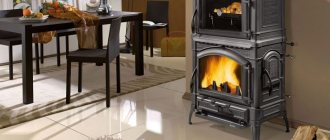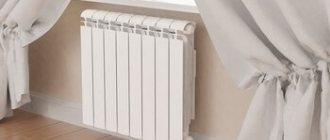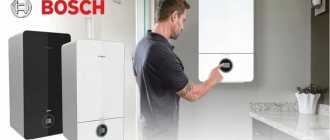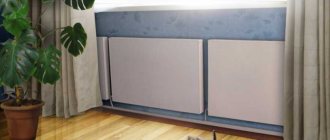Heating radiators are an indispensable attribute of any living space. Every year the number of consumers who are not satisfied with traditional products increases. Some people find them boring and boring, others cannot install them for technical reasons. We have to consider alternative options for heating living space.
What are tall radiators
Recently, residents are increasingly turning their attention to tall heating radiators. Sometimes they are also called vertical. This category includes products whose installation height is more than one meter. Every year they are gaining popularity.
Operating principle
Tall appliances work exactly the same as traditional ones. They are equipped with two pipes. The hot coolant enters the receiving area, gives off its energy and cools out through the outlet pipe.
In electric models, the coolant (oil or distilled water) heats the heating element (tubular electric heater). In “dry” electric heaters, the heating element immediately heats the body of the product, so heat transfer occurs faster.
The greatest difficulty when installing tall water units is the inconspicuous installation of pipes, which must either be hidden in a brick (concrete) wall or hidden behind plasterboard sheathing, and this is not always technically feasible.
Electric heaters are easier to connect. It is enough to install a socket with a voltage of 220 V.
Advantages
This type of heating device has a number of undeniable advantages.
These include:
- Rich choice. Manufacturers offer products in various colors, sizes and shapes.
- Great design. A correctly selected model fits easily into any interior.
- Ease of installation. Due to the supplied special mounting kit.
- Possibility of installation near stained glass walls. The products do not require window sills.
- High heating speed. The large surface area of the units significantly increases heat transfer.
- Space saving. In the niche under the window sill you can equip a small cabinet.
Flaws
Non-standard dimensions of vertical radiators imply the presence of a free wall. This is one of the disadvantages of these products.
Other disadvantages:
- Devices with bottom connections have a 10–15% reduced heat transfer. Lateral or diagonal connection is not always possible.
- Steel and cast iron units have a large mass, increasing the load on the supporting structures of the building.
- Difficulty in installing the heating main.
- High price. A simple vertical two-meter section costs from 4 to 10 thousand rubles. Exclusive designer models are several times more expensive.
- Uneven heating. The heated air rushes upward, accumulating in the ceiling area. The floor remains cool.
Rating of aluminum radiators
When compiling the review, thermal equipment from well-known companies was considered. Experts studied the characteristics, connection features, quality of decorative coating and efficiency. User reviews, opinions of heating engineers and equipment installers were taken into account. The main attention was paid to the following parameters:
- Power – affects the number of sections required for installation;
- Connection type – models with bottom and side connections are available;
- Manufacturing technology - injection molding is durable, extrusion has a low price;
- Size – determines the installation location;
- Withstand pressure - must correspond to the characteristics of the system.
Leaks, errors in the center distance, mechanical damage, low heat transfer - batteries with such defects were excluded from our rating.
Types of tall batteries
With all the wealth of choice, vertical units are divided into 2 large groups. In this regard, buyers are always faced with the question of which tall heating radiators to buy: water or electric. Here, a lot depends on the layout of the premises and on the family budget.
Water radiators
These models can often be seen in houses and apartments for one simple reason: heating a home with hot water is much cheaper than using electricity. And in terms of design, manufacturers offer a greater variety of models.
The non-demountable panel structure has a continuous flat facade. It could be a metal sheet, glass or mirror. Such models can act as independent interior items. The reflective mirror surface expands the space and adds light.
The tubular unit consists of upper and lower collectors connected by welding pipe sections. Quite often, the parts of the device are bent to give it an original shape. Most often, steel is chosen as the material for manufacturing. To maintain high heat transfer, pipes must be washed periodically on all sides.
Sectional radiators have a flat facade and consist of several parts.
They are characterized by the following features:
- look aesthetically pleasing;
- are aluminum or bimetallic;
- have the highest cost among other types of heating devices;
- collapsible design allows you to assemble the required number of sections in one product;
- give off heat according to the principle of convection;
- require minimal care.
If a private house has an autonomous heating system from a boiler, the type of design of the devices is not of fundamental importance. In any case, the generated thermal energy will be distributed throughout the living space.
Electric batteries
This type of heating units uses electrical energy to generate heat. Some devices are pumped with a working fluid as a coolant: distilled water or oil. Others work on the principle of direct heating, transferring energy from the heating element to the body of the device.
It is not economically feasible to use vertical electrical structures, therefore they are used extremely rarely as the main source of heating of premises. More often they are installed as an additional heating unit and operate in short-term mode, supporting the water heating system.
The equipment is equipped with thermostats integrated into the device, which allows the radiators to turn on automatically as soon as the temperature drops to a predetermined level. This product has its own target audience, albeit a small one.
How much do vertical radiators cost?
It should be noted that the price of wall-mounted electric radiators for summer cottages depends on the specific model, power and manufacturer.
For example, the narrowest vertical heater, 27 cm long and 180 cm high, Arbonia from a German manufacturer, will cost the buyer almost 10,000 rubles. But the Verta vertical battery costs even more - about 40,000 rubles.
True, there are more affordable options. You can buy cheaper wall-mounted electric heating radiators from a Chinese manufacturer. But you shouldn’t focus only on price when choosing vertical devices.
Because at a low price you can buy low-quality or counterfeit equipment. But it’s also better not to buy too expensive radiators. The ideal solution would be to choose a battery with the best price-quality ratio.
Non-standard models of vertical batteries are not easy to buy. They are rarely found on sale. Mostly they are made to order. Therefore, prices for heating radiators of unusual configurations will be high.
Types of radiators by material of manufacture
For the production of heating devices, various materials differing in certain properties are used. Each has its own advantages. Based on them, buyers make their choice. The offered product line allows you to satisfy any needs, depending on the taste of consumers and the thickness of the wallet.
Cast iron
Cast iron is a traditional material that has been used for the production of radiators for decades. It has the highest heat transfer, but a large mass, so devices with a height of just over a meter are classified as vertical. There is no point in mounting them on walls, the load is too large. In this regard, floor-mounted options are more often used.
Another disadvantage of this material is the difficulty of processing. The crude appearance of the cast iron connecting device is not admirable. But a way out was found. Art casting allows you to create samples akin to works of art. However, they are heavier in weight than traditional models, although they look very aesthetically pleasing.
Prices for cast iron heating radiators
cast iron radiators
Aluminum
Lightweight plastic metal allows you to give products any shape.
Aluminum heating devices have a number of advantages:
- heat up quickly;
- have good heat transfer;
- light in weight;
- cheap in cost.
However, they are not recommended for use in central heating systems due to high pressure. In addition, during seasonal testing of systems, there are hydraulic shocks, which can cause the product to rupture. Private houses with a boiler and an autonomous closed system are the most suitable place to install them.
Prices for aluminum heating radiators
aluminum radiators
Bimetallic
Two metals are used in production: the outer part is made of aluminum, the internal channels are made of steel. Thus, in one product it is possible to combine the best qualities of the original materials: the excellent thermal conductivity of aluminum and the strength of steel. Bimetallic models are wear-resistant, but expensive.
The ease of processing aluminum allows you to create very aesthetic samples, the color of which does not affect heat transfer at all. Models can decorate any interior, especially in combination with polypropylene pipes. The shape and appearance of bimetallic aggregates vary widely.
Steel
The strength of steel is undeniable. Heating sections made from it are distinguished by enviable strength, which cannot be said about heat transfer. It is the lowest for steel appliances. This metal is also susceptible to corrosion processes, which is its disadvantage. It is rarely possible to make something aesthetically pleasing out of pipes, but sometimes it is possible.
Models made from stainless steel pipes are especially good. They look beautiful and do not rust, which cannot be said about ordinary and alloy steel. That’s why they cover the devices with a front panel that hides all the imperfections. The advantage of steel radiators is their low cost.
Prices for steel heating radiators
steel radiators
Bottom line
Vertical heating radiators are an excellent choice for heating a residential or commercial space.
A wide range of sizes and shapes of structures and a variety of materials will allow you to mount the heating device in any heating system, both autonomous and centralized.
Choose vertical batteries taking into account the functional features of the room and the climatic conditions of the region in which you live.
By choosing and installing the battery according to all the rules, following the recommendations, you can be sure that it will not only serve you for many years, but will also provide a warm environment in the apartment during the winter.
Source: https://obogrevguru.ru/obzor-batarej-otopleniya-vertikalnogo-tipa.html
How to choose the right one
The question of choice is always of interest to consumers, especially when it comes to tall units. First of all, you need to take into account the height of the ceilings, since it can be 2.5 meters, and the products have a size of up to 3 meters. The main thing here is not to make a mistake, otherwise the product simply won’t fit.
For apartments and children's rooms it is better to take tubular models. They best meet the requirements and are safer.
Tubular radiators have a number of advantages:
- withstand pressure up to 10 atmospheres;
- connected by laser welding;
- smoothed corners prevent injury;
- uniform heating of the room;
- convenient cleaning.
The second point is the amount of heat required for a comfortable microclimate in the room. And in this regard, tubular models are convenient, since they can have from 1 to 6 rows in depth. If the unit will be mounted in a wall, you must first measure its width.
For private houses, the type of radiator is not of fundamental importance, since the pressure in the autonomous system is low and there is no risk of ruptures. Cast iron, aluminum, bimetallic, and steel models are suitable here. The main thing is that they fit harmoniously into the interior and evenly warm the room.
The best aluminum radiators with bottom connection
When connecting heating devices to the bottom, a built-in valve is used that automatically regulates the temperature. The absence of thermostats and air vents on the surface ensures an impeccable panel design. The main technical characteristics of aluminum heating radiators with a bottom connection are similar to devices with a side connection to the system.
Rifar Alum Ventil 500
A design feature of this series is the absence of welding work when sealing the bottom. An EPDM membrane and a plug are installed here. The absence of contact of the coolant with the seam increases the durability of the heating device. Intersectional connection is provided by an ethylene propylene rubber gasket, which is installed in a milled hole in the manifold. The result is a locking connection of increased reliability.
The vertical channel has a geometry that makes the coolant resistance minimal. The pressure is evenly distributed over the walls, making it possible to work with pressures of up to 20 atmospheres. The hydraulic unit and thermostatic valve are designed specifically for this series and are characterized by increased reliability.
Advantages:
- Effective dividers;
- Bright design;
- Uniform heating;
- Good equipment.
Flaws:
- Overcharge.
KZTO Elegant-mini 1
The aluminum alloy convector has a small height, which allows the equipment to be used when implementing complex design projects. This is the best option for houses with large windows whose sills are located at a very low height. The device has minimal impact on the design. Heating equipment is produced by a Russian company that has been on the market for 20 years and has an impeccable reputation.
The model is available in pass-through, ring, and diagonal versions, which allows it to be used in various types of systems. They are equipped with a built-in thermal valve, which operates stably throughout the entire service life. The decorative layer is glossy, resistant to mechanical stress and does not fade under the influence of heat.
Advantages:
- Average service life 25 years;
- Good convection;
- Withstands pressure up to 15 bar;
- Uniform heating.
Flaws:
- Overcharge.
The best bimetallic radiators
Review of popular models
In Russia, tall radiators are only gaining popularity. Their production is gradually being established. But consumers prefer products from foreign manufacturers, who are far ahead in technology and design. Imported units are distinguished by modern style, high efficiency, reliability and durability.
Kermi
Elegant flat panel Kermi Verteo units, produced in Germany, save not only energy, but also space, and therefore are becoming increasingly in demand. New technology with an innovative twist, Therm X2 is a progressive approach to creating a microclimate in modern conditions.
The products of this brand have a number of advantages:
- heats up 25% faster than similar models;
- saves energy up to 11%;
- The intensity of thermal radiation reaches 100%;
- height up to 3 meters;
- 5 year warranty.
The cost of Kermi panels varies from 260 to 920 euros, depending on the dimensions and row of the structure.
Guardo
Italian heating devices have a height of 1 meter. They were developed taking into account the climatic conditions of Russia. The minimum number of sections is 4, the maximum is 40. Installation in multi-storey buildings is allowed. Mounting type: floor or wall. Construction depth from 65 mm (two-pipe) to 215 mm (6-pipe).
The devices can operate on both water and antifreeze, which is very convenient. If the owners of a private house leave for a long time in winter, they do not have to worry that the system will defrost. Antifreeze does not freeze even at -40 °C. Connection type: side or bottom. Price - from 6 to 65 thousand rubles, depending on the number of sections. 10 year warranty.
Purmo
The Finnish manufacturer offers electric vertical radiators Delta Electric with a height of 1500 and 1800 mm, but they can make any size up to 3 meters to order. The product can be painted in the desired color. The heating element is equipped with a thermostat and an auto-shut-off timer.
The Delta Electric radiator is wall mounted and has the following technical parameters:
- width - 300 or 600 mm (6 or 12 sections);
- depth - 63 mm (2-pipe) and 101 mm (3-pipe);
- temperature adjustment from 30 to 70 °C;
- power - from 0.3 to 2 kW;
- power source - household socket with voltage 220 V;
- 10 year warranty.
The unit is equipped with a digital display, a connection box for hidden wiring, a towel rack and hooks. Price - from 38 to 68 thousand rubles.
Prices: summary table
| Model | Working pressure, atm | Maximum pressure, atm | Heat dissipation, W* | Cost of 1 section, rub. | Price, per 1 kW of power, thousand rubles. |
| Loten Gray V 1750 | 16 | 24 | 208 | 3400-4000 | 19 |
| KZTO Harmony 1-1750 | 15 | 20 | 512 | 1200 – 2100 (factory holiday) | 2,3–4 |
| Arbonia 2180 | 10 | 15 | 209 | 3000 – 4000 | 15–20 |
| Royal Thermo PianoForte Tower | 15 | 45 | 200 | 2000 | 10 |
| Mandarin 1200 Alum | 15 | 16 | 210 | 3500 – 4000 | 16–19 |
| Purmo Vertical | 6 | 10 | Depending on size | According to price |
*Note. Measurements are carried out at a temperature difference between the coolant and air in the room equal to 70°C
When choosing vertical radiators, you should pay close attention to the technical characteristics of the products declared by the manufacturer and confirmed by certificates. In this case, it will be possible to avoid accidents in the heating system and additional costs for equipment repairs.
Heating radiators
Installation recommendations
The significant height of vertical radiators excludes their traditional installation under window sills. For these products you will need completely different places. This needs to be taken into account before purchasing. Otherwise, certain difficulties may arise. It is also worth thinking about the correct piping.
Where to install
To install vertical models, partitions between windows are often used, but a regular wall or partition will do. The main thing is that it is durable if the unit is steel or cast iron. Such products have a significant mass. If the partition is plasterboard, it is better to use the floor option.
If there is a niche in the room, it can also be used for a radiator. A corner of the room will also work. Modern models are equipped with everything necessary for installation: brackets, overlays, fasteners. It is recommended to install a heated towel rail in bathrooms, which is included in the package of many manufacturers.
The heater must not be covered with furniture to avoid reducing heat transfer. It should be open, especially since modern products have a stylish design and can decorate any interior.
How to connect
The connection diagram largely depends on the technical capabilities of the pipe connection. For example, if in a private house the autonomous heating system has a top connection (a straight pipe runs along the top), then you should look for a radiator with a top connection. With bottom wiring, the connection can be lateral, diagonal or bottom.
A saddle connection, when the forward and return lines approach the bottom of the unit horizontally on both sides, is not recommended, since with this scheme losses of thermal energy will be observed. Practice has shown that in this case, heat transfer is reduced to 25%.
For the same reason, the top connection is not used for bottom wiring of the heating system. A connection is considered to be downstream when the forward and return pipes come out of the floor. Most foreign manufacturers integrate a thermoregulation mechanism into their units. It is configured at the factory. You need to remember this.
In such heating devices, the direction of the working medium is always one-sided. How the coolant should flow through the radiator is indicated in the product’s operating manual. If you connect it the other way around, at best, the unit simply will not heat up, and at worst, the thermoregulation mechanism will fail.
Comparison of tall vertical batteries with horizontal ones: advantages and disadvantages
| Properties | Vertical radiators | Horizontal (classic) radiators | |
| Appearance | Designer execution | Designer execution or standard solutions for everyday tasks | |
| Temperature maintenance | Depends on the correctness of the calculations | ||
| Price | High | Average or budget | |
| Safety | High with the right choice of equipment | ||
| Life time | From 5 to 10 years warranty with the right choice of equipment | ||
| Manufacturability | Easy installation | ||
| Balancing | Requires experience with different radiators in the system | Simple | |
| Working and maximum pressure | Operating modes are taken into account when purchasing equipment | ||
The following are important for installers and the operating organization:
- manufacturability (ease) of installation and replacement;
- convenience of balancing the heating system in a private house;
- compliance of technical characteristics with operating conditions - type of coolant and maximum operating pressure.
Based on the totality of the evaluated parameters, it can be understood that vertical batteries have two important advantages over conventional radiators:
- an unusual appearance that adds style to the room and increases the status of the owner in the eyes of guests;
- ease of use for certain types of design.
The main disadvantage for the mass consumer is the high price of the product.
Experts note the difficulty of setting up the system if the composition includes different types of batteries - in this case, it is sometimes difficult to achieve the same flow of coolant through the convectors.
What to do if the bottom or top of the battery is cold
In the case of a cold top, the reason most often lies in the air accumulated in this part of the heating device. One has only to bleed it using a special valve (called the “Mayevsky valve”), and the functionality of the connecting device is restored. Some foreign models have an automatic valve that bleeds air as it accumulates.
With a cold bottom the situation is more complicated.
It can cool down for a number of reasons:
- system blockage;
- insufficient coolant pressure;
- low temperature of the working environment;
- incorrect radiator connection diagram;
- The valve (ball valve) is installed incorrectly.
Once the specific cause is identified, the problem must be corrected. The blockage is cleared by disassembling the system and then flushing it. The low temperature is increased using a thermostat for a gas or electric boiler, which has several modes for heating the coolant. The pressure of the working medium is increased by inserting a circulation booster pump.
An incorrectly installed ball valve or valve is dismantled and turned 180 degrees. On the body of the shut-off and control valves there is an arrow in the direction of movement of the working medium. If the bottom is cold due to an incorrect connection diagram, it is changed by re-cutting. For example, the saddle version is replaced with a diagonal one. Read about wood heating stoves for your home on our website.











